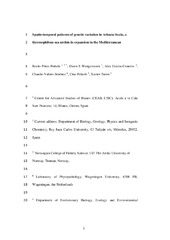| dc.contributor.author | Pérez-Portela, Rocío | |
| dc.contributor.author | Wangensteen Fuentes, Owen Simon | |
| dc.contributor.author | García-Cisneros, Alex | |
| dc.contributor.author | Valero-Jiménez, Claudio | |
| dc.contributor.author | Palacín, Creu | |
| dc.contributor.author | Turon, Xavier | |
| dc.date.accessioned | 2019-02-06T12:50:36Z | |
| dc.date.available | 2019-02-06T12:50:36Z | |
| dc.date.issued | 2018-06-14 | |
| dc.description.abstract | The genetic structure of 13 populations of the amphiatlantic sea urchin <i>Arbacia lixula</i>, as well as temporal genetic changes in three of these localities, were assessed using ten hypervariable microsatellite loci. This thermophilous sea urchin is an important engineer species triggering the formation of barren grounds through its grazing activity. Its abundance seems to be increasing in most parts of the Mediterranean, probably favoured by warming conditions. Significant genetic differentiation was found both spatially and temporally. The main break corresponded to the separation of western Atlantic populations from those in eastern Atlantic and the Mediterranean Sea. A less marked, but significant differentiation was also found between Macaronesia (eastern Atlantic) and the Mediterranean. In the latter area, a signal of differentiation between the transitional area (Alboran Sea) and the rest of the Mediterranean was detected. However, no genetic structure is found within the Mediterranean (excluding Alboran) across the Siculo-Tunisian Strait, resulting from either enough gene flow to homogenize distance areas or/and a recent evolutionary history marked by demographic expansion in this basin. Genetic temporal variation at the Alboran Sea is as important as spatial variation, suggesting that temporal changes in hydrological features can affect the genetic composition of the populations. A picture of genetic homogeneity in the Mediterranean emerges, implying that the potential expansion of this keystone species will not be limited by intraspecific genetic features and/or potential impact of postulated barriers to gene flow in the region. | en_US |
| dc.description.sponsorship | The Spanish Government projects | en_US |
| dc.description | Submitted manuscript version. Published version available at <a href=https://doi.org/10.1038/s41437-018-0098-6> https://doi.org/10.1038/s41437-018-0098-6</a>. | en_US |
| dc.identifier.citation | Pérez-Portela, R., Wangensteen Fuentes, O.S., García-Cisneros, A., Valero-Jiménez, C., Palacín, C. & Turon, X. (2018). Spatio-temporal patterns of genetic variation in <i>Arbacia lixula</i>, a thermophilous sea urchin in expansion in the Mediterranean. <i>Heredity, 122</i>, 244-259. https://doi.org/10.1038/s41437-018-0098-6 | en_US |
| dc.identifier.cristinID | FRIDAID 1592394 | |
| dc.identifier.doi | 10.1038/s41437-018-0098-6 | |
| dc.identifier.issn | 0018-067X | |
| dc.identifier.issn | 1365-2540 | |
| dc.identifier.uri | https://hdl.handle.net/10037/14632 | |
| dc.language.iso | eng | en_US |
| dc.publisher | Springer Nature | en_US |
| dc.relation.journal | Heredity | |
| dc.rights.accessRights | openAccess | en_US |
| dc.subject | VDP::Agriculture and fishery disciplines: 900::Fisheries science: 920 | en_US |
| dc.subject | VDP::Landbruks- og Fiskerifag: 900::Fiskerifag: 920 | en_US |
| dc.title | Spatio-temporal patterns of genetic variation in Arbacia lixula, a thermophilous sea urchin in expansion in the Mediterranean | en_US |
| dc.type | Journal article | en_US |
| dc.type | Tidsskriftartikkel | en_US |


 English
English norsk
norsk